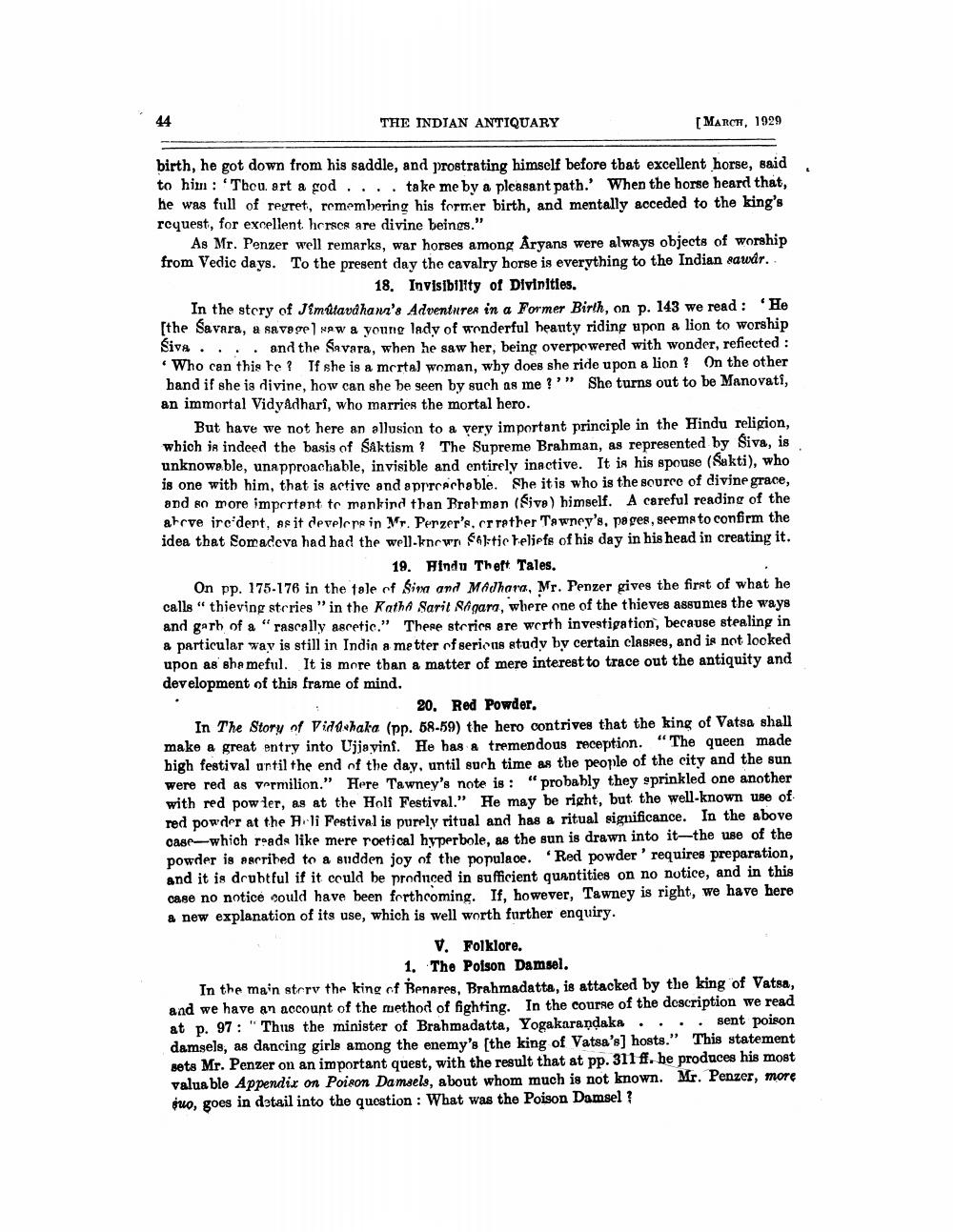________________
THE INDIAN ANTIQUARY
[MARCH, 1929
.
birth, he got down from his saddle, and prostrating himself before that excellent horse, said to him: 'Thou art a god,... take me by a pleasant path. When the horse heard that, he was full of regret, remembering his former birth, and mentally acceded to the king's request, for excellent horses are divine beings."
As Mr. Penzer well remarks, war horses among Aryans were always objects of worship from Vedic days. To the present day the cavalry horse is everything to the Indian saudr..
18. Invisibility of Divinities. In the story of Jimitavahana's Adventurer in a Former Birth, on p. 143 we read : He [the Savara, a savage) xewa young lady of wonderful heanty riding upon a lion to worship Sivs .... and the Savara, when he saw her, being overpowered with wonder, refiected : • Who can this he? If she is a mertal woman, why does she ride upon a lion ? On the other hand if she is divine, how can she be geen by such as me?'" She turns out to be Manovati, an immortal Vidyadhari, who marries the mortal hero.
But have we not here an allusion to a very important principle in the Hindu religion, which is indeed the basis of Saktism? The Supreme Brahman, as represented by Siva, is unknowable, unapproachable, invisible and entirely inactive. It is his spouse (Sakti), who is one with him, that is active and approachable. She itis who is the source of divine grace, and so more important to mankind than Bretmen (Sive) himself. A careful reading of the ahrve ire'dent, as it develere in Mr. Perzer's.cr rather Tawney's, pages, seems to confirm the idea that Somadeva had had the well-known astic reliefs of his day in his head in creating it.
19. Hindu Theft Tales. On pp. 175.176 in the tale of Siv and Madhara, Mr. Penzer gives the first of what he calls " thieving stories" in the Katha Sarit Nagara, where one of the thieves assumes the ways and garh of a "rascally ascetic." There strrics are worth investigation, because stealing in a particular way is still in Indin a metter of serious study by certain classes, and is not looked upon as she meful. It is more than a matter of mere interest to trace out the antiquity and development of this frame of mind.
20. Red Powder, In The Story of Vidd haka (pp. 58-59) the hero contrives that the king of Vatsa shall make a great entry into Ujjayins. He has a tremendous reception. “The queen made high festival until the end of the day, until such time as the people of the city and the sun were red as vermilion." Here Tawney's note is : " probably they sprinkled one another with red pow ler, as at the Holf Festival." He may be right, but the well-known use of red powder at the Ali Festival is purely ritual and has a ritual significance. In the above case-which reads like mere roetical hyperbole, as the sun is drawn into it—the use of the powder is ascribed to a sudden joy of the populace. "Red powder' requires preparation, and it is drubtful if it could be prodnced in sufficient quantities on no notice, and in this case no notice could have been frrthcoming. If, however, Tawney is right, we have here a new explanation of its use, which is well worth further enquiry.
V. Folklore.
1. The Poison Damsel. In the main strev the king of Benares, Brahmadatta, is attacked by the king of Vatsa, and we have an account of the method of fighting. In the course of the description we read at p. 97: "Thus the minister of Brahmadatta, Yogakarandaka .... sent poison damsels, as dancing girls among the enemy's (the king of Vatsa's) hosts." This statement sets Mr. Penzer on an important quest, with the result that at pp. 311 ff. be produces his most valuable Appendir on Poison Damsels, about whom much is not known. Mr. Penzer, more fuo, goes in detail into the question: What was the Poison Damsel?




